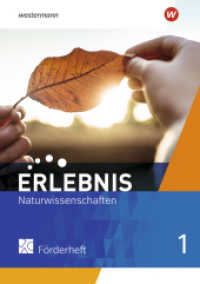- ホーム
- > 洋書
- > ドイツ書
- > Mathematics, Sciences & Technology
- > Earth Science
- > geography
Full Description
This book provides insights from a geoscientist's perspective into the benefits and the potential of remote sensing methods to address problems with a high social impact: identifying the drivers of geohazards and developing new methods for monitoring natural resources. The fields covered include volcanic hazards, seismic hazards, landslide hazards, land subsidence hazards and monitoring of natural resources through the use and combination of various remote sensing techniques and modelling approaches. This book should spark collaborations and encourage readers to think beyond disciplines or techniques, as well as enable readers to build their own workflow depending on their study of interest. It provides a much-needed comprehensive review of recent advances that remote sensing methods have brought to geohazards and resources research. It is unique in the way that it unifies geohazards and natural resources research to highlight cross-field advancements and potential areas for multiple fields of science to collaborate.
The book intends to provide both a basic understanding of the remote sensing methods used in geohazards and natural resources sciences, with appropriate referencing for readers wishing to further their technique-specific learning, and a detailed application of these methods to a variety of sustainability problems. It aims at providing the reader with workflows for combining multiple techniques with demonstrated results in a variety of disciplines. This approach makes the book useful for both students learning about geohazards and resources, learning about remote sensing methods, and for researchers intending to expand their skill set using methods that have been applied to other fields. This book provides an introduction to each remote sensing method with references for in-depth technical learning which will benefit students in Remote Sensing courses.
Contents
Chapter 1: Enhancing stewardship of Earth through remote sensing.- Part 1: Remote sensing methods in geohazards and resource monitoring.- Chapter 2: The Global Navigation Satellite System (GNSS): Positioning, Velocities, and Reflections.- Chapter 3: Interferometric Synthetic Aperture Radar (InSAR).- Chapter 4: Lidar for geohazard and natural resource characterization.- Chapter 5: Optical Geodesy and the Measurement of Ground Deformation by Image Correlation.- Chapter 6: The Gravity Recovery and Climate Experiment (GRACE).- Chapter 7: Thermal Remote Sensing.- Chapter 8: Multibeam Echosounder.- Part 2: Geohazards - Volcanic.- Chapter 9: Remote sensing of volcano deformation and surface change.- Chapter 10: Gas and thermal emissions of volcanoes.- Chapter 11: Modeling of remote sensing data: common practices, state of the art, and limitations.- Part 3: Geohazards - Volcanic.- Chapter 12: Fault structure from space.- Chapter 13: Rapid characterization of damages.- Chapter 14: The seismic cycle: from observations to models of fault slip.- Part 4: Geohazards - Land subsidence.- Chapter 15: Land subsidence hazards: a case study of Mexico City.- Chapter 16: Quantifying subsidence in tropical peatlands.- Chapter 17: Mining/post-mining surface deformation.- Chapter 18: Sinkholes.- Chapter 19: Natural compaction of sediments.- Chapter 20: Coastal flooding and structure stability.- Part 5: Geohazards - Landslide.- Chapter 21: Landslide hazards.- Chapter 22: Underwater mass wasting.- Part 6: Natural resources - Water.- Chapter 23: Observations of confined aquifer systems.- Chapter 24: Large-scale terrestrial water storage changes sensed by geodesy.- Chapter 25: Bridging the scale gap between ground deformation and gravity: tools for sustainability.- Part 7: Natural resources - Gas and hydrocarbon exploitation.- Chapter 26: Carbon capture and storage.- Chapter 27: Hydraulic fracturing.- Part 8: Future of remote sensing methods.- Chapter 28: Future of remote sensing for geohazards and resource monitoring.- Part 9: Application of remote sensing in other domains of geosciences.- Chapter 29: Space geodetic sensing of atmospheric water vapor and its application.- Chapter 30: Oceans.- Chapter 31: Cryospheric applications of remote sensing: snow water equivalent.








